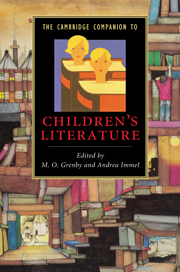Book contents
16 - Humour and the body in children’s literature
from Part III - Forms and Themes
Published online by Cambridge University Press: 28 November 2010
Summary
Children's humour depends largely on the body. Not entirely, but largely. Slapstick, caricature, parody, the grotesque, ridicule and the improbable in human predicaments concern the body, and so too does nonsense. A glance over Edward Lear's limericks or Lewis Carroll's Alice books will illustrate how often nonsense is associated with the body (long noses, wild hair, elongated bodies, collapsed bodies and so on). Reversals often deal with the matter of size: big and little, as we see in a number of recent films for children, like Big (1988), The Kid (2000) and 13 Going on 30 (2004). Even verbal humour may derive its effect from the body. Remember when we were kids, we often chanted 'Sticks and stones will break my bones, but names [or words] can never hurt me.' We were, of course, wrong. Words do relate to and register on the body. Just take names, for example. Funny names are often a reflection of the body, by implication if not by denotation: Leonard Neeble, Norman Bleistift, Mr Gutzman, Fat Albert, Freckles, Bonnie McSmithers, Gertrude McFuzz, Nicholas Knock, Margery Meanwell - these names are metonymic of the kind of person who carries the name. And we do not need to look farther than the Harry Potter books to see that words, other than names, can have dramatic effects on the body, as when Dudley got a pig's tail when Hagrid recited a spell of transfiguration.
- Type
- Chapter
- Information
- The Cambridge Companion to Children's Literature , pp. 258 - 271Publisher: Cambridge University PressPrint publication year: 2009
- 4
- Cited by

